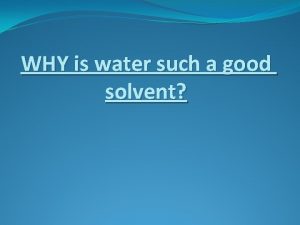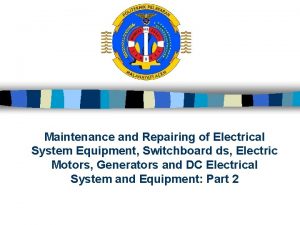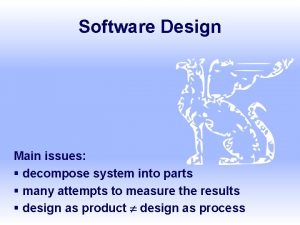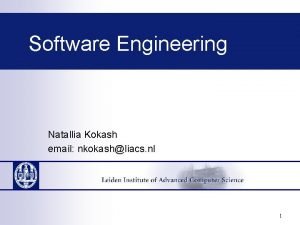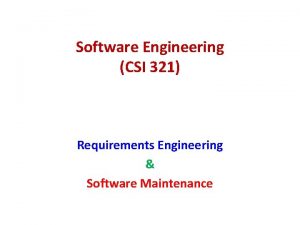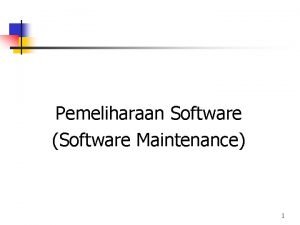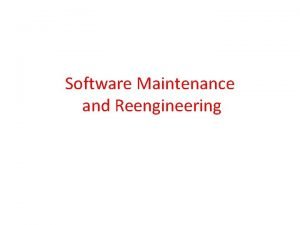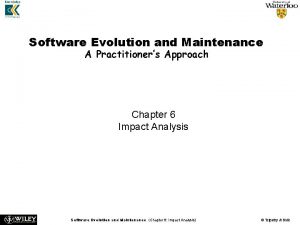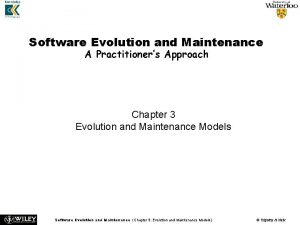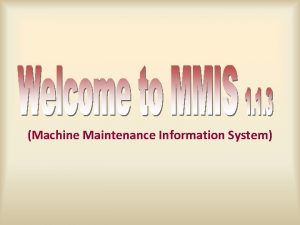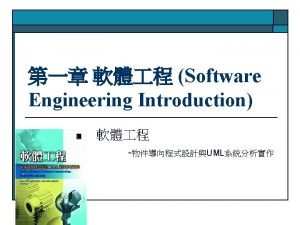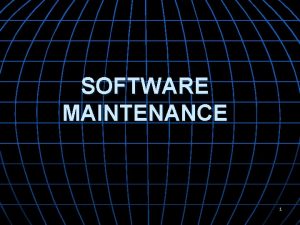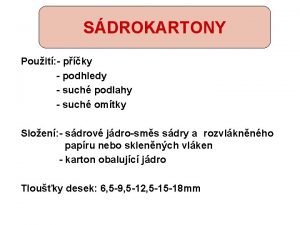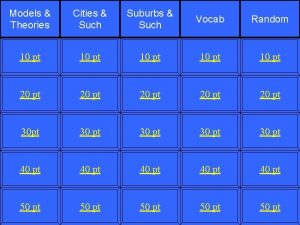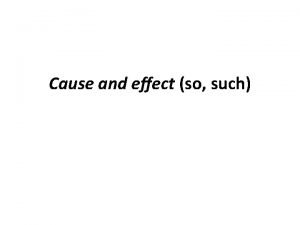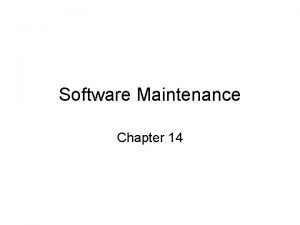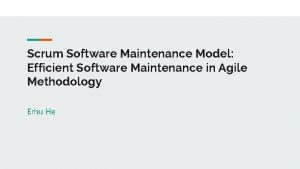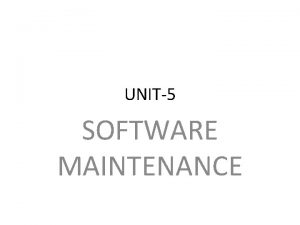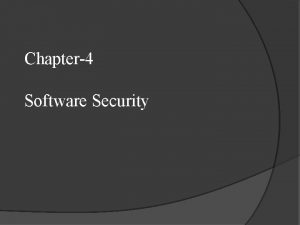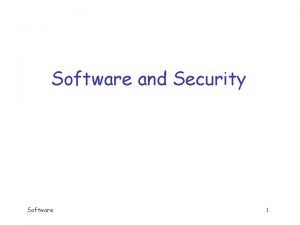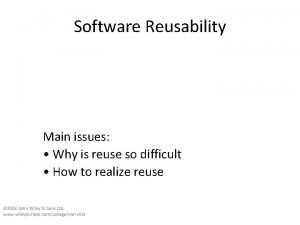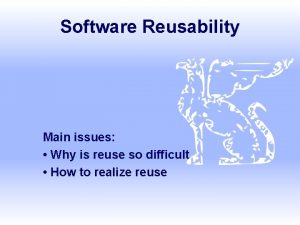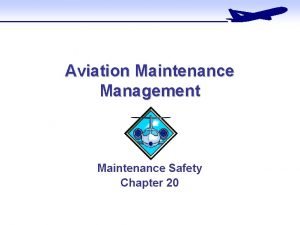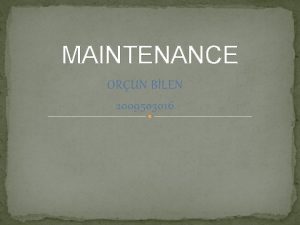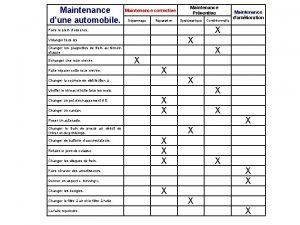Software Maintenance Main issues why maintenance is such































- Slides: 31

Software Maintenance Main issues: § why maintenance is such an issue § reverse engineering and its limitations § how to organize maintenance

Relative distribution of software/hardware costs 100 Percent of total cost Hardware Development 60 Software 20 1955 Maintenance 1970 Year 1985 SE, Maintenance, Hans van Vliet, © 2008 2

Point to ponder #1 § Why does software maintenance cost so much? SE, Maintenance, Hans van Vliet, © 2008 3

Software Maintenance, definition The process of modifying a software system or component after delivery to correct faults, improve performance or other attributes, or adapt to a changed environment SE, Maintenance, Hans van Vliet, © 2008 4

Maintenance is thus concerned with: § correcting errors found after the software has been delivered § adapting the software to changing requirements, changing environments, . . . SE, Maintenance, Hans van Vliet, © 2008 5

Key to maintenance is in development § Higher quality less (corrective) maintenance § Anticipating changes less (adaptive and perfective) maintenance § Better tuning to user needs less (perfective) maintenance § Less code less maintenance SE, Maintenance, Hans van Vliet, © 2008 6

Kinds of maintenance activities § corrective maintenance: correcting errors § adaptive maintenance: adapting to changes in the environment (both hardware and software) § perfective maintenance: adapting to changing user requirements § preventive maintenance: increasing the system’s maintainability SE, Maintenance, Hans van Vliet, © 2008 7

Distribution of maintenance activities corrective 21% perfective 50% adaptive 25% preventive 4% SE, Maintenance, Hans van Vliet, © 2008 8

Growth of maintenance problem § 1975: ~75, 000 people n maintenance (17%) § 1990: 800, 000 (47%) § 2005: 2, 500, 000 (76%) § 2015: ? ? (Numbers from Jones (2006)) SE, Maintenance, Hans van Vliet, © 2008 9

Shift in type of maintenance over time § Introductory stage: emphasis on user support § Growth stage: emphasis on correcting faults § Maturity: emphasis on enhancements § Decline: emphasis on technology changes SE, Maintenance, Hans van Vliet, © 2008 10

Major causes of maintenance problems § Unstructured code § Insufficient domain knowledge § Insufficient documentation SE, Maintenance, Hans van Vliet, © 2008 11

Reverse engineering SE, Maintenance, Hans van Vliet, © 2008 12

Reverse engineering § Does not involve any adaptation of the system § Akin to reconstruction of a blueprint § Design recovery: result is at higher level of abstraction § Redocumentation: result is at same level of abstraction SE, Maintenance, Hans van Vliet, © 2008 13

Restructuring § Functionality does not change § From one representation to another, at the same level of abstraction, such as: § From spaghetti code to structured code § Refactoring after a design step in agile approaches § Black box restructuring: add a wrapper § With platform change: migration SE, Maintenance, Hans van Vliet, © 2008 14

Reengineering (renovation) § Functionality does change § Then reverse engineering step is followed by a forward engineering step in which the changes are made SE, Maintenance, Hans van Vliet, © 2008 15

Refactoring in case of bad smells § Long method § Large class § Primitive obsession § Data clumps § Switch statements § Lazy class § Duplicate code § Feature envy § Inappropriate intimacy §… SE, Maintenance, Hans van Vliet, © 2008 16

Categories of bad smells § Bloaters: something has grown too large § Object-oriented abusers: OO not fully exploited § Change preventers: hinder further evolution § Dispensables: can be removed § Encapsulators: deal with data communication § Couplers: coupling too high SE, Maintenance, Hans van Vliet, © 2008 17

Program comprehension § Role of programming plans, beacons § As-needed strategy vs systematic strategy § Use of outside knowledge (domain knowledge, naming conventions, etc. ) SE, Maintenance, Hans van Vliet, © 2008 18

Software maintenance tools § Tools to ease perceptual processes (reformatters) § Tools to gain insight in static structure § Tools to gain insight in dynamic behavior § Tools that inspect version history SE, Maintenance, Hans van Vliet, © 2008 19

Analyzing software evolution data § Version-centered analysis: study differences between successive versions § History-centered analysis: study evolution from a certain viewpoint (e. g. how often components are changed together) SE, Maintenance, Hans van Vliet, © 2008 20

Example version-centered analysis SE, Maintenance, Hans van Vliet, © 2008 21

Example history-centered analysis SE, Maintenance, Hans van Vliet, © 2008 22

Organization of maintenance § W-type: by work type (analysis vs programming) § A-type: by application domain § L-type: by life-cycle type (development vs maintenance) § L-type found most often SE, Maintenance, Hans van Vliet, © 2008 23

Advantages of L-type departmentalization § Clear accountability § Development progress not hindered by unexpected maintenance requests § Better acceptance test by maintenance department § Higher Qo. S by maintenance department § Higher productivity SE, Maintenance, Hans van Vliet, © 2008 24

Disadvantages of L-type departmentalization § Demotivation of maintenance personnel because of status differences § Loss of system knowledge during system transfer § Coordination costs § Increased acceptance costs § Duplication of communication channels with users SE, Maintenance, Hans van Vliet, © 2008 25

Product-service continuum and maintenance SE, Maintenance, Hans van Vliet, © 2008 26

Service gaps 1. Expected service as perceived by provider differs from service expected by customer 2. Service specification differs from expected service as perceived by provider 3. Service delivery differs from specified services 4. Communication does not match service delivery SE, Maintenance, Hans van Vliet, © 2008 27

Gap model of service quality SE, Maintenance, Hans van Vliet, © 2008 28

Maintenance control § Configuration control: § Identify, classify change requests § Analyze change requests § Implement changes § Fits in with iterative enhancement model of maintenance (first analyze, then change) § As opposed to quick-fix model (first patch, then update design and documentation, if time permits) SE, Maintenance, Hans van Vliet, © 2008 29

Indicators of system decay § Frequent failures § Overly complex structure § Running in emulation mode § Very large components § Excessive resource requirements § Deficient documentation § High personnel turnover § Different technologies in one system SE, Maintenance, Hans van Vliet, © 2008 30

SUMMARY § most of maintenance is (inevitable) evolution § Maintenance problems: § § Unstructured code Insufficient knowledge about system and domain Insufficient documentation Bad image of maintenance department § Lehman’s 3 rd law: a system that is used, will change SE, Maintenance, Hans van Vliet, © 2008 31
 Hey bye bye
Hey bye bye Software maintenance in software engineering ppt
Software maintenance in software engineering ppt Don't ask why why why
Don't ask why why why Why am i such a perfectionist
Why am i such a perfectionist Why is water such a good solvent?
Why is water such a good solvent? Bergeron meaning
Bergeron meaning Summarizing is a powerful reading strategy it increases
Summarizing is a powerful reading strategy it increases Why was rome such a dangerous place in the 70s bc?
Why was rome such a dangerous place in the 70s bc? How does iago plant the seed of jealousy in othello
How does iago plant the seed of jealousy in othello Switch board maintenance
Switch board maintenance Future i will
Future i will Main idea and supporting details
Main idea and supporting details Void main int main
Void main int main Software security issues
Software security issues Design issues in software engineering
Design issues in software engineering Codepro analytix
Codepro analytix Adaptive maintenance in software engineering
Adaptive maintenance in software engineering Evolvability
Evolvability Types of software changes
Types of software changes Adaptive software maintenance
Adaptive software maintenance Maintenance and reengineering in software engineering
Maintenance and reengineering in software engineering Ripple effect in software maintenance
Ripple effect in software maintenance Software maintenance
Software maintenance Machine maintenance software
Machine maintenance software What is the main purpose of writing
What is the main purpose of writing What are the main software categories
What are the main software categories Categories of software in computer
Categories of software in computer Main categories of software
Main categories of software Why-why analysis
Why-why analysis Why do you cry willy
Why do you cry willy Does the table represent a function why or why not
Does the table represent a function why or why not Does this table represent a function why or why not
Does this table represent a function why or why not




